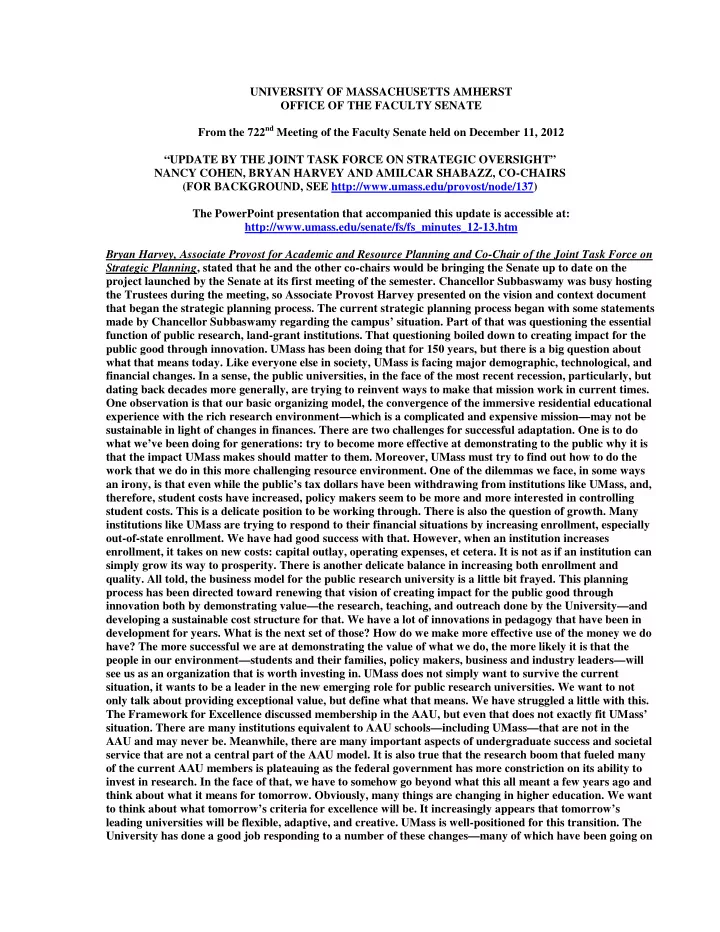

UNIVERSITY OF MASSACHUSETTS AMHERST OFFICE OF THE FACULTY SENATE From the 722 nd Meeting of the Faculty Senate held on December 11, 2012 “UPDATE BY THE JOINT TASK FORCE ON STRATEGIC OVERSIGHT” NANCY COHEN, BRYAN HARVEY AND AMILCAR SHABAZZ, CO-CHAIRS (FOR BACKGROUND, SEE http://www.umass.edu/provost/node/137) The PowerPoint presentation that accompanied this update is accessible at: http://www.umass.edu/senate/fs/fs_minutes_12-13.htm Bryan Harvey, Associate Provost for Academic and Resource Planning and Co-Chair of the Joint Task Force on Strategic Planning , stated that he and the other co-chairs would be bringing the Senate up to date on the project launched by the Senate at its first meeting of the semester. Chancellor Subbaswamy was busy hosting the Trustees during the meeting, so Associate Provost Harvey presented on the vision and context document that began the strategic planning process. The current strategic planning process began with some statements made by Chancellor Subbaswamy regarding the campus’ situation. Part of that was questioning the essential function of public research, land-grant institutions. That questioning boiled down to creating impact for the public good through innovation. UMass has been doing that for 150 years, but there is a big question about what that means today. Like everyone else in society, UMass is facing major demographic, technological, and financial changes. In a sense, the public universities, in the face of the most recent recession, particularly, but dating back decades more generally, are trying to reinvent ways to make that mission work in current times. One observation is that our basic organizing model, the convergence of the immersive residential educational experience with the rich research environment—which is a complicated and expensive mission—may not be sustainable in light of changes in finances. There are two challenges for successful adaptation. One is to do what we’ve been doing for generations: try to become more effective at demonstrating to the public why it is that the impact UMass makes should matter to them. Moreover, UMass must try to find out how to do the work that we do in this more challenging resource environment. One of the dilemmas we face, in some ways an irony, is that even while the public’s tax dollars have been withdrawing from institutions like UMass, and, therefore, student costs have increased, policy makers seem to be more and more interested in controlling student costs. This is a delicate position to be working through. There is also the question of growth. Many institutions like UMass are trying to respond to their financial situations by increasing enrollment, especially out-of-state enrollment. We have had good success with that. However, when an institution increases enrollment, it takes on new costs: capital outlay, operating expenses, et cetera. It is not as if an institution can simply grow its way to prosperity. There is another delicate balance in increasing both enrollment and quality. All told, the business model for the public research university is a little bit frayed. This planning process has been directed toward renewing that vision of creating impact for the public good through innovation both by demonstrating value—the research, teaching, and outreach done by the University—and developing a sustainable cost structure for that. We have a lot of innovations in pedagogy that have been in development for years. What is the next set of those? How do we make more effective use of the money we do have? The more successful we are at demonstrating the value of what we do, the more likely it is that the people in our environment—students and their families, policy makers, business and industry leaders—will see us as an organization that is worth investing in. UMass does not simply want to survive the current situation, it wants to be a leader in the new emerging role for public research universities. We want to not only talk about providing exceptional value, but define what that means. We have struggled a little with this. The Framework for Excellence discussed membership in the AAU, but even that does not exactly fit UMass’ situation. There are many institutions equivalent to AAU schools—including UMass—that are not in the AAU and may never be. Meanwhile, there are many important aspects of undergraduate success and societal service that are not a central part of the AAU model. It is also true that the research boom that fueled many of the current AAU members is plateauing as the federal government has more constriction on its ability to invest in research. In the face of that, we have to somehow go beyond what this all meant a few years ago and think about what it means for tomorrow. Obviously, many things are changing in higher education. We want to think about what tomorrow’s criteria for excellence will be. It increasingly appears that tomorrow’s leading universities will be flexible, adaptive, and creative. UMass is well-positioned for this transition. The University has done a good job responding to a number of these changes—many of which have been going on
Recommend
More recommend